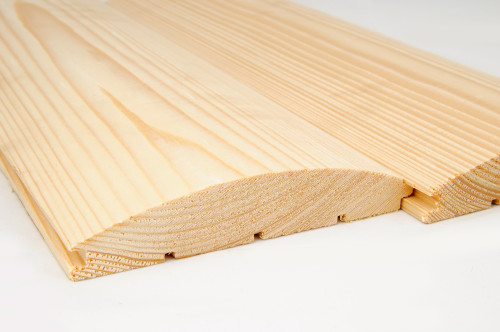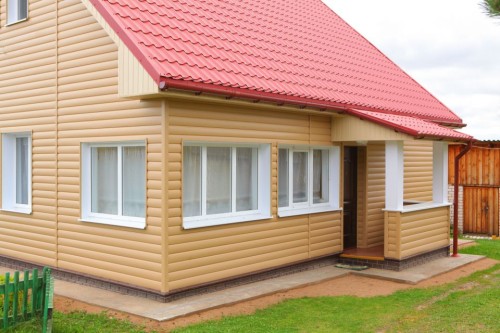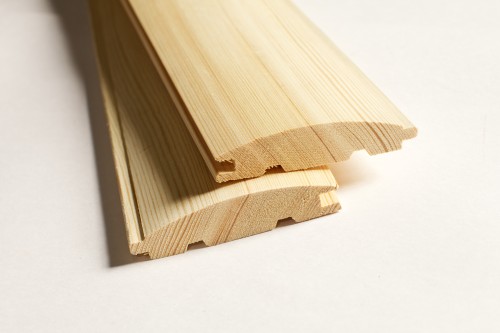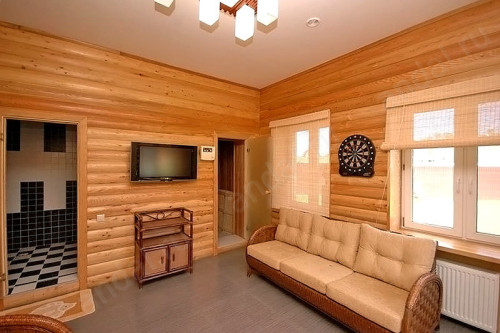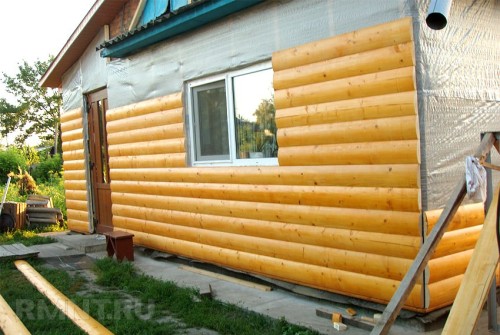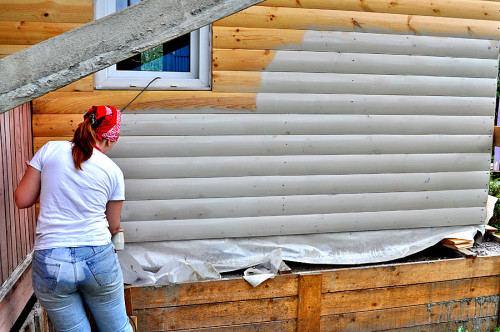
Finish at home block house Walls,Building materials
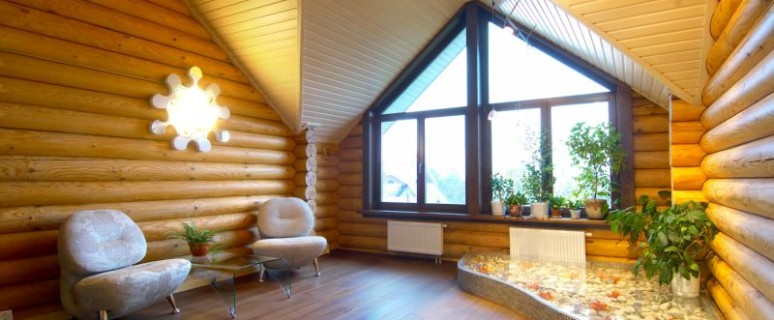
Block House as finishing material applied in the construction sphere relatively recently. It is a finishing board having a flat rear and convex front profile. On the one hand, such a board is a groove, on the other - spike. With the help of these items, the material docking is carried out. As a raw material for the manufacture of the Haus block uses dried wood with a normal humidity rate, not exceeding 15%. Consider all the features of the application of this cladding.
Content
Features of the material
The main rocks of the wood from which the House Block is manufactured is larch and pine. Each of these breeds has its advantages.
- Pine material is more durable and distinguished by the best waterproofing qualities due to the presence of resins in the wood.
- Finishing boards from larch are beneficial to the fact that under the influence of humidity not only do not lose their positive operational qualities, but also become much stronger. In terms of density indicators, larch can be compared with oak wood. Pine in this respect is inferior to this breed.
Thanks to the use of natural materials, ready-made boards The House Block has a number of positive properties. The advantages of finishing the house block House are as follows:
- resistance to deformation;
- environmental Safety;
- long service period;
- resistance to fungus;
- attractive appearance;
- the material is not subject to crack formation as a result of the effects of high temperature;
- simplicity of installation technology;
- available cost.
It should also be remembered that the vapor permeability of the Haus block is rather low. Therefore, it is recommended to perform finishing with this material in those houses where the owners live on an ongoing basis. If the house is regularly opposed and cool, in this case there is a risk of accumulating under the wrapping of moisture. This will have a negative impact on the condition of the walls.
Finishing houses block House. Photo:
Varieties block Haus
Block House is classified by seventh types:
- category A material;
- block House B. B.
Sometimes there may be transitional species in the market, such as A / B and V / s. Consider the features and characteristics of each category.
- The highest quality indicators are the material relating to the group A. Such boards may have healthy, not affected by rotches, but not more than 5 units on the board. The following is also allowed:
- the presence of thin cracks, the size of no more than 30 cm;
- resin pockets no more than 5 cm;
- weakly expanded defects, such as roughness and minor recesses.
- The material of the category B has fewer quality requirements. On the boards, smallery pockets may be present in an unlimited quantity. Allowed:
- the presence of bitch, but not more than 3 units on the product;
- cracks;
- ductivity;
- fringe up to 30%.
Features of the interior decoration
Block House - universal finishing material, which is suitable for both outdoor and internal facing of the room. Thanks to the performance characteristics, this surface is simultaneously decorative finishing at home and thermal insulation material.
So, for mounting the Haus block will need the following set of tools:
- boards block house;
- bars;
- antiseptic;
- brush;
- level;
- hammer;
- saw;
- sandpaper;
- self-tapping screw;
- drill.
Preparatory stage
Before mounting, the House block must pass a certain processing.
- First, the boards should be decomposed on the free surface and in such a state to leave for several days. Thus, a kind of "acclimatization" of the material occurs, which will further reduce its shrinkage.
- Next, using a painting tassel, you need to apply an antiseptic drug on the surface of the boards, without forgetting to process the grooves and spikes.
- After the first processing on the material, various irregularities and roughness will become more visible. They need to be eliminated using sandpaper.
- Then the second layer of the antiseptic means should be applied. As a result of these actions, the material will be protected from the negative impact of ultraviolet rays. In specialized points of sale, you can find antiseptics of various colors and shades.
Fastening process Block Haus
For interior decorations, narrow boards are used, the width of which ranges from 80-90 mm. The installation process itself occurs in such a sequence of actions:
- The wall is mounted on the wall of boards, rails or timber, which are located every 50 cm.
- On top of this design, the boards are stacked. If the room has high ceilings, it is recommended to start mounting work at the top. Since downstairs is much easier to adjust the material in width.
- For decoration, a self-tapping screw or special galvanized locks - kleimers are used to decide the unit. When using a kleimer, one part of this element must be beatened to the "groove" of the boards, and another to attach to the crate by screwing. Use Kleimer has a certain advantage. In this case, there is no need to apply nails or self-tapping screws. Due to this, the risk of damage to the panel practically disappears.
- After the installation is completed, the kleimers are hidden using platbands or plinths.
- When mounting panels, it is necessary to make a hole in the board by means of screws, corresponding to half of its thickness.
- Then the screw is inserted into this hole. This method has a certain disadvantage - the probability of damage to the panels and the occurrence of cracks.
Exterior decoration using the Haus block
The outer decoration of the wooden house Block House is carried out using wide boards whose width varies from 130 to 230 mm. Installation is carried out on the crate. If it is necessary to insulate the house between the frames of the frame, insulating material is stacked.
Important! Special attention should be paid to waterproofing, since moisture accumulation will occur under the finishing material. It is also necessary to perform vapor barrier. You can lose this moment only if the surface that is expected to be facing is made of BRUS. This material has the property to be compared in humidity indicators with a block house, and the vaporia layer will create an obstacle to eliminate moisture.
External cladding Block House is carried out with the following requirements:
- In the process of external finishing work, it is recommended to use metal kleimers, as in this case, the House block has a significant width, as a result of which is heavy and massive.
- The mounting to the grille is performed using self-samples on the Schip-Paz system.
- The front of the boards must be strengthened. To do this, the holes are dried in them with drings, after which it is connected to a screw with a crate.
- To give the finish an attractive look, hide the screws with the help of wooden plugs that are attached to PVA glue.
Performing a finish by means of the Haus block can be encountered with certain difficulties:
- In particular, problems can arise with the docking of the boards at the corners of the house. To solve this problem, the construction industry offers special plinths and corners. However, when using them, it is not always possible to successfully adjust parts of the finishing material. In this situation, the corner walls will be expelled as the best option, after which they hide the joint with the help of lining.
- Another problem may occur in the process of installing the last boards. It will need to be adjusted under certain parameters and trim. In this case, the situation can be corrected using a wooden plinth.
- Also, difficulty can cause door and window openings, to finish which you need to use exclusively special platbands. These items will not only solve decorative tasks and hide the slots, but will also prevent the penetration into the placement of moisture and cold. Installation of such platbands is performed by means of glue, screws or nails. At the same time, it is necessary to use only elements made on the basis of galvanized metal. If we apply ordinary nails or self-tapping screws for this purpose, when moisture gets into moisture, they will rust, which in turn can cause rotting wood panels.
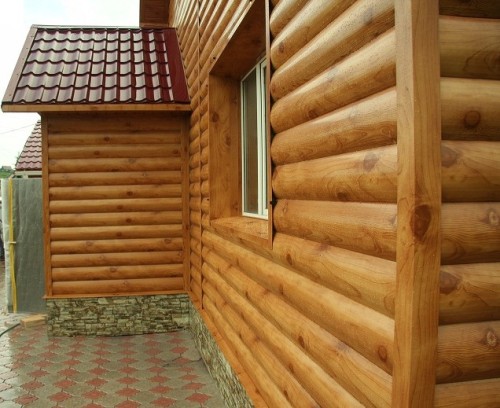
Finishing work
The House block after a certain time changes its color and darkens. To save the finish in the original color, the panels must be covered with protective agents. For this purpose, you can use varnish or wax oil. The effectiveness of the use of varnish remains in doubt, because There are two opinions. According to the first, the wood covered with varnish is quite well preserved. However, some masters claim that the lacquer is still unable to prevent the blackening of the wood material.
Under the influence of wax oil, the color of the material varies to a slight degree. Components included in this agent prevent the formation of spots on wood and make it more stable. Updated oil coating is needed every 3-4 years. You can protect the panels and by applying ordinary paint. In this case, the layer update should be carried out once every 5-7 years. Each of these funds must be applied primarily on the lock system and the end parts of the boards. Also possible processing of panels before installation.
Conclusion
Block House is an innovative finishing material with sufficient advantages. This material for a long time will give an aesthetic appearance of the house, since it has a long service life and is not deformed as a result of various mechanical effects. And what is important is safe for health, as it is made of environmental raw materials. Panel Haus block are suitable for both internal and outdoor decoration. And the process of finishing the house outside the unit is characterized by simplicity and ease.
Facing a fellow house. Video:




